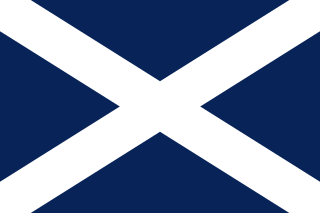
Tenerife is the largest and most populous island of the Canary Islands. It is home to 42.9% of the total population of the archipelago. With a land area of 2,034.38 square kilometres (785.48 sq mi) and a population of 948,815 inhabitants as of January 2023, it is also the most populous island of Spain and of Macaronesia.
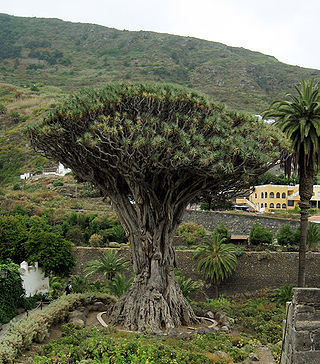
Icod de los Vinos is a municipality in the province of Santa Cruz de Tenerife on the island of Tenerife, in the Canary Islands (Spain), located in the northwestern part of the island. Inhabitants of Icod are known in Spanish as "icodenses".

A lava tube, or pyroduct, is a natural conduit formed by flowing lava from a volcanic vent that moves beneath the hardened surface of a lava flow. If lava in the tube empties, it will leave a cave.

Cueva de los Verdes is a lava tube and tourist attraction of the Haria municipality on the island of Lanzarote in the Canary Islands (Spain). The cave lies within the Monumento Natural del Malpaís de La Corona, a protected area of the Canary Islands.

Tejeda is a village and a municipality in the mountainous central part of the island of Gran Canaria in the province of Las Palmas in the Canary Islands.

A show cave—also called tourist cave, public cave, and, in the United States, commercial cave—is a cave which has been made accessible to the public for guided visits.

TITSA is the Transportes interurbanos de Tenerife, S.A. which operates almost all public bus services in Tenerife, on the Canary Islands. It carries over 60 million travellers a year in a fleet of approximately 600 vehicles.

Malpaís de Güímar or Badlands of Guimar consist of a volcanic cone, subsidiary cones, and several basaltic lava flows in the Güímar municipality on the island of Tenerife, in the Canary Islands, Spain. They total in area about 290 hectares. The lava flows are quite recent, with the typical ʻaʻā type less than 10,000 years old. The large cone is called Montaña Grande and reaches a height of 276 m (906 ft).
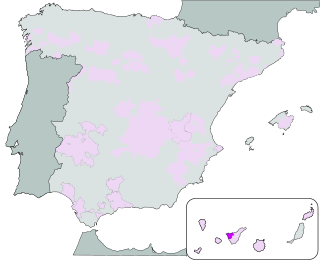
Ycoden-Daute-Isora is a Spanish Denominación de Origen Protegida (DOP) for wines located in the western part of the island of Tenerife. It acquired its DO status in 1994.
The Cueva de Don Justo is one of approximately 70 caves and volcanic galleries on the island of El Hierro in the Canaries.

The Cave of the Guanches, or Archaeological area of the Cave of the Guanches, is an important archaeological site located in the north of the island of Tenerife.
The Caves of Don Gaspar is an important archaeological site located in the north of the island of Tenerife.
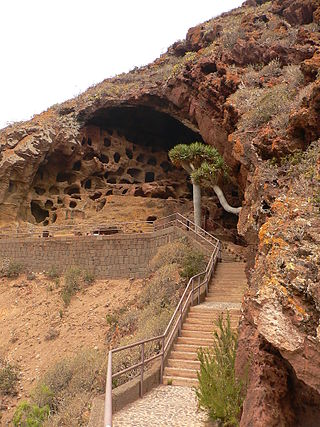
Valerón's "monastery" is an archaeological site on the Spanish island of Grand Canary, in the municipality of Santa Maria de Guia, on Valerón's cliff. It is the largest pre-Hispanic collective granary built before Roman times and used by the island's inhabitants until the conquest of the island at the end of the 15th century.

The Painted cave is an archaeological museum and park in the town of Galdar, located the northwest of Grand Canary in the Canary Islands, Spain. This centre is part of the Spanish Ministry of Culture, Historic Heritage and Museums of the town council of Grand Canary.
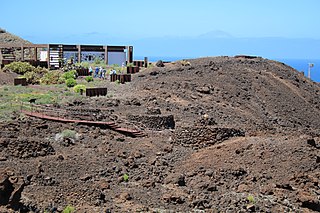
The El Maipés necropolis is an ancient burial site near Agaete on the Spanish island of Grand Canary, province of Las Palmas in the Canary Islands of the west coast of Africa.
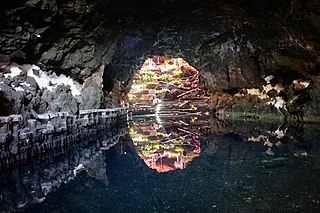
Jameos del Agua is a series of lava caves, located in the municipality of Haría in northern Lanzarote, Canary Islands, Spain. It is also an art, culture and tourism center, created by local artist and architect, César Manrique, and managed by the government of Lanzarote. Jameos del Agua consists of a subterranean salt lake, restaurant, gardens, emerald-green pool, museum and auditorium.

El Drago, also known as Drago Milenario and Drago de Icod de los Vinos, is the oldest and largest living specimen of Dracaena draco, or dragon tree, in Parque del Drago, Icod de los Vinos, Tenerife, Spain. It is said to be a thousand years old, although the age is disputed. It is one of the symbols of Tenerife, and was declared a national monument in 1917.

Drago Park is a park and one of the main visitor attractions in Icod de los Vinos, Tenerife. Created at the turn of the millennium, it contains El Drago Milenario, a dragon tree thought to be around 1,000 years old, as well as a variety of other native plants.

















